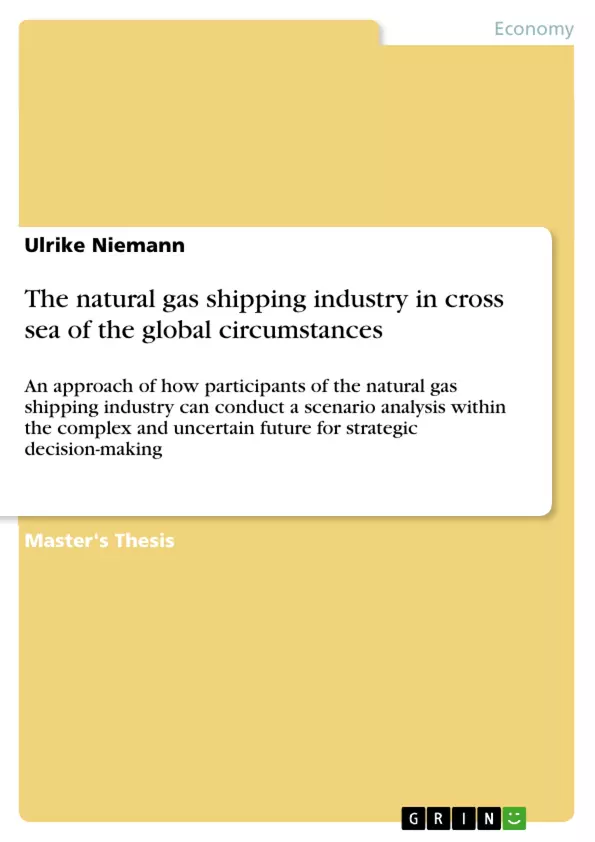Shipping of natural gas across the oceans is of significant importance – linking the energy production business with the consuming nations around the globe. Natural gas supply is predicted to increment 1.9% p.a. until 2035, therewith facilitating its transportation as a commodity on board of currently 415 liquefied natural gas vessels and further 168 more to come by 2020. Despite its comparably small size of not even one percent of the worldwide merchant fleet within the industry of shipping, the carriage of natural gas on board of vessels has been overall on an upwind within the last twenty years, foremost due to the greater discovery of natural gas as a source of energy and an increased demand for energy resources in general.
Particularly the natural gas shipping industry underlies peculiar states of affairs: It is a highly technologized, investment intense segment which is affected by currents of political, economic, and environmental origin. Hence, natural gas shipowners as well as other participants upstream and downstream of this sector find themselves in difficulty of strategic decision-making. The purpose for this study has therefore been to investigate in how a natural gas shipping company and other market participants can take a farsighted strategic decision in the complex and uncertain business environment of today and, thereby, planning for the future. By using the scenario approach of modelling a complex world in single happenings, it will be thought deeply and creatively about the future whereof the most salient factors affecting this industry are illuminated. Upon these scenarios, various economic theories and models including an equation of natural gas ships demand are applied whose concepts could be exercised by market participants in order to adapt to ever-changing circumstances with vigilance and to reduce the risk of being unprepared for the future.
The study found that the global natural gas industry is impacted by the dynamics deriving from conditions enforced by, for instance, the ongoing financial and economic crisis, legislative forces, substitutionary effects of energy products, and political discord in natural gas providing as well as receiving countries. The outer-firm global contexts leave a footprint on the strategic decision-making of a firm. In addition, it was proofed that scenario conduction is a viable tool for strategic planning of a firm active in the natural gas shipping field in order to address the business ...
Inhaltsverzeichnis (Table of Contents)
- Abstract
- Introduction
- Theoretical Framework
- Scenario planning
- Scenario planning methodology
- Defining the scope
- Identifying the key factors
- Developing scenario narratives
- Developing strategic responses
- Global energy supply and demand
- The role of natural gas
- Global demand for natural gas
- Global supply of natural gas
- Outlook on global energy supply
- The natural gas shipping industry
- Economic models in the natural gas shipping industry
- Methodology
- Qualitative methodology
- Scenario development technique
- Defining the scope of the scenario
- Identifying the key factors
- Developing the scenarios
- Results
- Scenario narratives
- Scenario 1: The Growth Scenario
- Scenario 2: The Sustainability Scenario
- Scenario 3: The Volatility Scenario
- Strategic implications for the natural gas shipping industry
- Discussion
- Scenario analysis for strategic decision-making
- Implications for the natural gas shipping industry
- Limitations of the study
- Conclusion
Zielsetzung und Themenschwerpunkte (Objectives and Key Themes)
This study aims to explore how participants in the natural gas shipping industry can utilize scenario analysis to make informed strategic decisions amidst a complex and uncertain future. It investigates how this industry, heavily impacted by global forces and a dynamic business environment, can plan for the future by analyzing various potential scenarios.
- Scenario planning methodology in the natural gas shipping industry
- Global energy supply and demand dynamics, particularly the role of natural gas
- Economic models applicable to the natural gas shipping sector
- Strategic implications of scenario analysis for industry participants
- The impact of global uncertainty on strategic decision-making
Zusammenfassung der Kapitel (Chapter Summaries)
- Abstract: Introduces the study's objective, which is to explore how the natural gas shipping industry can use scenario analysis for strategic decision-making in a complex and uncertain environment. It highlights the study's focus on the global context, including the role of natural gas in the global energy market.
- Introduction: Provides an overview of the natural gas shipping industry, its importance in the global energy market, and the challenges faced by industry participants due to global uncertainty and dynamic market forces.
- Theoretical Framework: Discusses the key theoretical concepts that inform the study, including scenario planning methodology, global energy supply and demand, and economic models relevant to the natural gas shipping industry.
- Methodology: Outlines the qualitative methodology used in the study, emphasizing the scenario development technique employed to analyze different future possibilities.
- Results: Presents the scenario narratives developed in the study, depicting various potential future scenarios for the natural gas shipping industry.
- Discussion: Analyzes the implications of the scenario analysis for strategic decision-making within the natural gas shipping industry, highlighting the importance of considering different future possibilities.
Schlüsselwörter (Keywords)
The study revolves around the key concepts of scenario planning, global energy supply and demand, natural gas shipping, strategic decision-making, and economic models. It explores the impact of global uncertainty on the natural gas shipping industry and aims to provide insights into how participants can navigate this challenging business environment through informed strategic planning.
- Quote paper
- Ulrike Niemann (Author), 2015, The natural gas shipping industry in cross sea of the global circumstances, Munich, GRIN Verlag, https://www.grin.com/document/315556



